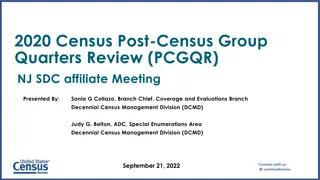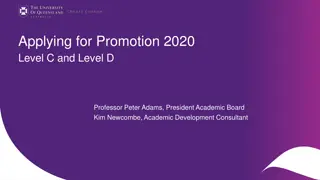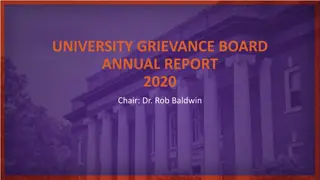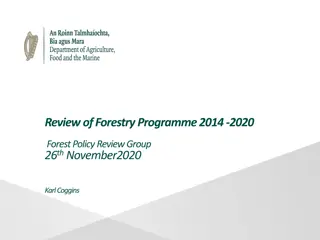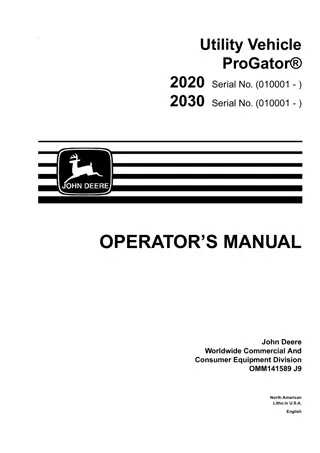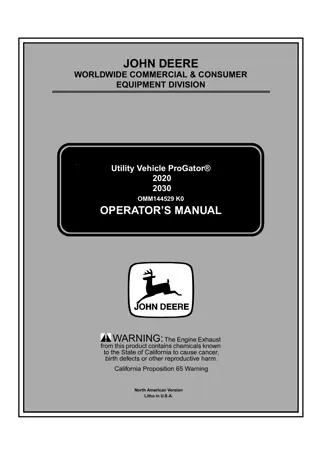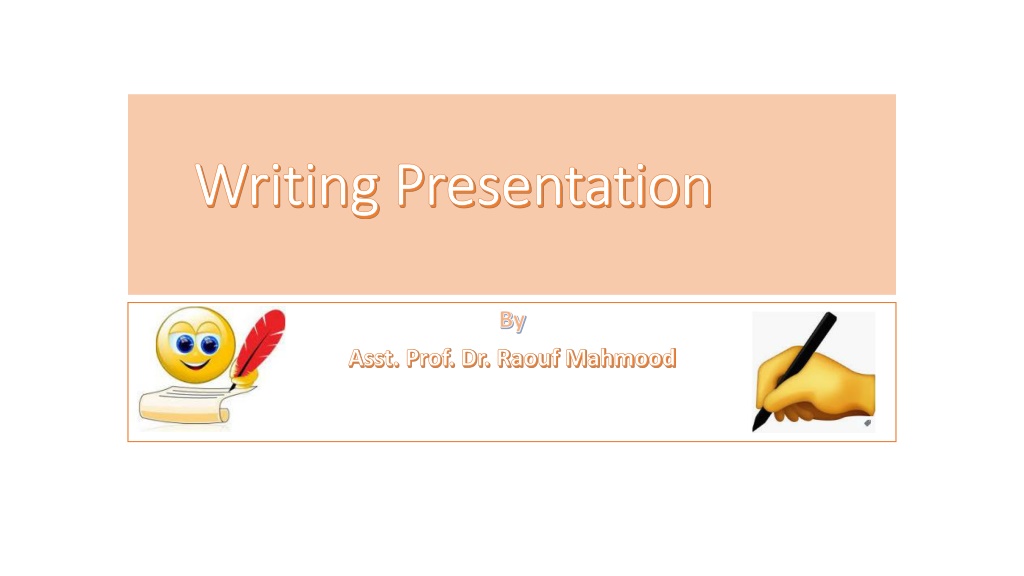
Effective Strategies for Presentation Writing
Learn how to prepare persuasive and informative presentations with the guidance of Asst. Prof. Dr. Raouf Mahmood. Discover essential steps like audience analysis, topic selection, and defining presentation objectives to create engaging content. Understand the importance of structuring your presentation's body to effectively convey ideas and keep your audience engaged.
Download Presentation

Please find below an Image/Link to download the presentation.
The content on the website is provided AS IS for your information and personal use only. It may not be sold, licensed, or shared on other websites without obtaining consent from the author. Download presentation by click this link. If you encounter any issues during the download, it is possible that the publisher has removed the file from their server.
E N D
Presentation Transcript
Writing Presentation Writing Presentation By Asst. Prof. Dr. Raouf Mahmood
Presentation Persuasive Presentations Informative Presentations influence a change in the belief, attitude, or behavior of another person when that person has some degree of free choice. The purpose of informative presentations is to approve understanding of an idea or to deliver information. They are often used to provide people with information about a concept or idea that is new.
Steps in Preparing a Presentation Steps in Preparing a Presentation Planning Your Presentation Preparing a presentation can be an amazing experience if you allow it to be one. The strategies and steps below are provided to help you break down what you might view as a large job into smaller, more manageable tasks.
Steps in Preparing a Presentation Steps in Preparing a Presentation Step 1: Analyse your audience The first step in preparing a presentation is to learn more about the audience to whom you'll be speaking. It's a good idea to obtain some information on the backgrounds, values, and interests of your audience so that you understand what the audience members might expect from your presentation. Step 2: Select a topic If possible select a topic that is of interest to the audience and to you. It will be much easier to deliver a presentation that the audience finds significant, and more enjoyable to research a topic that is of interest to you.
Steps in Preparing a Presentation Steps in Preparing a Presentation Step 3: Define the objective of the presentation Once you have selected a topic, write the objective of the presentation in a single short statement. The objective needs to specify exactly what you want your audience to learn from your presentation. Base the objective and the level of the content on the amount of time you have for the presentation and the background knowledge of the audience. Use this statement to help keep you focused as you research and develop the presentation.
Preparing the Content of Your Preparing the Content of Your Presentation Presentation Step 4: Prepare the body of the presentation After defining the objective of your presentation, determine how much information you can present in the amount of time allowed. Also, use your knowledge about the audience to prepare a presentation with the right level of detail. You don't want to plan a presentation that is too basic or too advanced. The body of the presentation is where you present your ideas. To present your ideas strongly, you will need to illustrate and support them. Strategies to help you do this include the following: Present data and facts Read citation from specialists Relate personal experiences Provide bright descriptions And remember, as you plan the body of your presentation it's important to provide variation. Listeners may quickly become bored by lots of facts or they may tire of hearing story after story.
Preparing the Content of Your Preparing the Content of Your Presentation Presentation Step 5: Prepare the introduction and conclusion Once you've prepared the body of the presentation, decide how you will begin and end the talk. Make sure the introduction captures the attention of your audience and the conclusion summarizes and repeats your important points. In other words, "Tell them what you're going to tell them. Tell them. Then, tell them what you told them." During the opening of your presentation, it's important to attract the audience's attention and build their interest. If you don't, listeners will turn their attention elsewhere and you'll have a difficult time getting it back.
Preparing the Content of Your Preparing the Content of Your Presentation Presentation Strategies that you can use include the following: Make the introduction relevant to the listeners' goals, values, and needs Ask questions to stimulate thinking Share a personal experience Begin with a joke or funny story Project a cartoon or colourful visual Make a stimulating or inspirational statement Give a unique demonstration
Preparing the Content of Your Preparing the Content of Your Presentation Presentation During the opening you want to clearly present your topic and the purpose of your presentation. Clearly express the topic and purpose will help the listeners focus on and easily follow your main ideas. During the conclusion of your presentation, support the main ideas you communicated. Remember that listeners won't remember your entire presentation, only the main ideas. By reinforcing and reviewing the main ideas, you help the audience remember them.
Practicing and Delivering Practicing and Delivering Step 6: Practice delivering the presentation Most people spend hours preparing a presentation but very little time practicing it. When you practice your presentation, you can reduce the number of times you complete words and phrases like, "um," "well," and "you know." These habits can easily reduce a speaker's believability. You can also fine-tune your content to be sure you make your most important points in the time chosen. In addition to planning the content of your presentation, you need to give advanced thought to how you want to deliver it. Do you want to commit your presentation to memory, use cards to guide you, or read from a script? Or, you might want to use a combination of methods.
Speaking Speaking Methods Methods To help you decide, read the advantages and disadvantages of the four delivery methods described below. Speaking from Memory A distinct advantage of speaking from memory is your ability to speak to the audience without depending on notes or a script. This allows you the flexibility to move away from the podium and to maintain eye contact with the audience. However, speaking from memory has disadvantages, too. Presentations from memory often sound rehearsed and the possibility exists that you'll forget an important point, present information that's inaccurate, or completely lose your train of thought. If you decide to deliver your presentation from memory, have notes handy to jog your memory just in case!
Speaking Speaking Methods Methods Speaking from Notes Many people like to speak from notes. Typically these notes are either on cards or paper in outline form and contain key ideas and information. If you are using an electronic presentation tool, you may be able to include your notes in the presentation itself. The advantage of delivering a presentation from notes is that you sound natural rather than prepared and you can still maintain relatively good eye contact with the audience. The disadvantage is that it might not express your key ideas and thoughts as well as you may have liked had you planned your exact words in advance.
Speaking Speaking Methods Methods Speaking from Text Involves writing your speech out, word for word, then basically reading from the text. As with speaking from memory, an advantage of this method is that you plan, in advance, exactly what you're going to say and how you're going to say it. A disadvantage is that you might appear to the audience to be stiff. You will need to make frequent eye contact and speak with expression to maintain the audience's interest.
Speaking Speaking Methods Methods Using a Combination of Methods You may find the best method to be a combination of all three. For instance, experts suggest you memorize the first and last ten minutes of your talk so that you can speak perfectly and without notes. Notes may be suitable for segments of your presentation that you know very well. Finally, speaking from a text might be appropriate when you have quotes or other important points that you want to make sure you communicate accurately and completely. You can make a smooth continuation to written text by saying something like: "I want to read this quote to you accurately, to ensure that I don't misrepresent the original intent."
Being a Credible Speaker Being a Credible Speaker Be accurate and exact with quotes, names, dates, and facts. Provide support for your ideas. Dress in a professional manner. Use visual aids that look professional. Know your material. Use language that's appropriate for the audience members.
Use Humor Effectively Use Humor Effectively Never embarrass anyone. Use humor that is acceptable to the group. Most humor is culture specific.
Controlling Nervousness Controlling Nervousness Be prepared. Practise just previous to the speech. Greet people. Make eye contact with them before your speech. Take deep breaths and try to relax your body.
Visual Aids in Presentations Visual Aids in Presentations Use visual aids to emphasize important points only. Give the visuals a consistent appearance. Select the appropriate visual aid for the environment. Make sure the text is large enough for people in the back of the room to read. Use a simple type face for visuals. Don't show visuals that conflict with what you're saying. Don't read the text that's on the visual but paraphrase and add to it.
Establish a Comfortable Environment Establish a Comfortable Environment Make sure lighting, heat, and sound is good. Make sure all equipment is available and is working properly. Adjust the seating arrangements as needed.
Thank You Thank You

